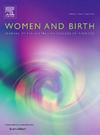Childbirth and parenting education via telehealth: A two-phased cross-sectional exploration of rural and remote stakeholders’ perceptions and experiences
IF 4.4
2区 医学
Q1 NURSING
引用次数: 0
Abstract
Problem
Globally, health services have transitioned to deliver childbirth and parenting education (CPE) via telehealth, with limited understanding of the impact of these changes.
Background
CPE is important for preparing prospective parents for birth and the immediate postnatal period. Access to education can be challenging for those living in rural and remote areas.
Aim
This study aimed to explore rural and remote consumers’ and clinicians’ experiences and perspectives of using, accessing or providing CPE via telehealth.
Methods
A two-phased cross-sectional study conducted via online survey, followed by 1:1 online interviews. Quantitative data were analysed using descriptive and inferential statistics; qualitative data were analysed using inductive thematic analysis.
Findings
A total n = 279 survey participants responded. Half (49.6 %) would have preferred face-to-face education, 40 % would not have accessed CPE if telehealth modality was not available. A quarter of women (25.6 %) reported saving > $500. Most clinicians (73 %) reported telehealth classes supported workload management. In total, 21 interviews were conducted, three main themes were identified i) Using telehealth for CPE Program, ii) Course content and iii) Intersection with the health service.
Discussion
Findings support the continuation of telehealth CPE classes, with hybrid availability where possible. Further research is warranted on the value of CPE expressed more strongly by multiparas over primiparas. Further research on the important role of telehealth enabling inclusion of fathers and partners is warranted.
Conclusion
Recognising that many still prefer face-to-face education; service providers and policy makers can have confidence in the supportive nature of telehealth CPE for key stakeholders.
求助全文
约1分钟内获得全文
求助全文
来源期刊

Women and Birth
NURSING-OBSTETRICS & GYNECOLOGY
CiteScore
7.20
自引率
13.20%
发文量
371
审稿时长
27 days
期刊介绍:
Women and Birth is the official journal of the Australian College of Midwives (ACM). It is a midwifery journal that publishes on all matters that affect women and birth, from pre-conceptual counselling, through pregnancy, birth, and the first six weeks postnatal. All papers accepted will draw from and contribute to the relevant contemporary research, policy and/or theoretical literature. We seek research papers, quality assurances papers (with ethical approval) discussion papers, clinical practice papers, case studies and original literature reviews.
Our women-centred focus is inclusive of the family, fetus and newborn, both well and sick, and covers both healthy and complex pregnancies and births. The journal seeks papers that take a woman-centred focus on maternity services, epidemiology, primary health care, reproductive psycho/physiology, midwifery practice, theory, research, education, management and leadership. We also seek relevant papers on maternal mental health and neonatal well-being, natural and complementary therapies, local, national and international policy, management, politics, economics and societal and cultural issues as they affect childbearing women and their families. Topics may include, where appropriate, neonatal care, child and family health, women’s health, related to pregnancy, birth and the postpartum, including lactation. Interprofessional papers relevant to midwifery are welcome. Articles are double blind peer-reviewed, primarily by experts in the field of the submitted work.
 求助内容:
求助内容: 应助结果提醒方式:
应助结果提醒方式:


